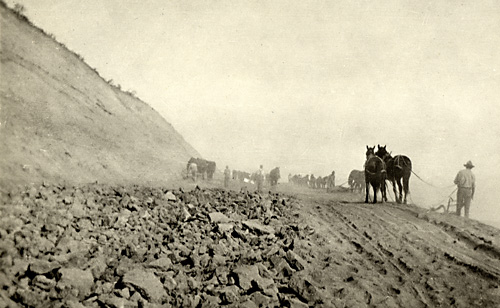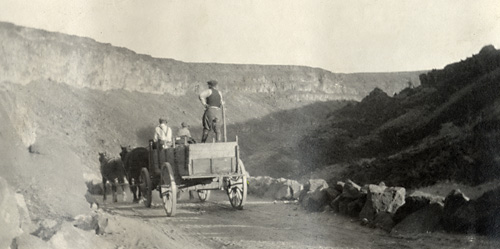 |
||
|
Building Roads in the Mountains of Idaho with horses and hand operated scrapers
 The men in the picture above may be showing off their new "Fresno Scraper" that had just replaced the older, smaller, and less efficient "Buck Scraper." A bit of explanation is in order here regarding the spelling and pronunciation of the word "Conant." The Conant Valley is a small valley that lies in a bend of the Snake River between Ririe, Idaho and Swan Valley, Idaho. From Ririe one travels East up onto the dry farms and then descends down to the Snake River and thence into the Conant Valley. The road from the dry farms down to the Snake River was known to the locals as the Coonard Dugway. Presumably this road was named after the Conant Valley and the early settlers called it the Coonard or Cooner Valley. My father, Kenneth Morgan, worked on the building of the first roads through this large gully (called a dugway) and he called it the Cooner Dugway. So we are assuming here that Cooner and Coonard are simply local pronunciations of Conant. |
|||
|
The Conant Dugway is a roadbed that was built in a big gully (or small canyon) that connects the high, hilly dry farms East of Ririe Idaho with the Snake River where it enters the small Conant Valley. In the late 1800's a crude, hand dug and axe hewn single track wagon road wound through this canyon. This early road was used by our Morgan/Moore/Radford/Ryset ancestors when they moved from Freedom (Now Etna) Wyoming to Shelton, Idaho in 1891. In the early 1900's an improved winding road was built down this gully so that wagons (and soon after, the newly arrived automobiles) could more easily travel from Idaho Falls, Idaho to Swan Valley, Idaho and on to Wyoming's Star Valley or Idaho's Teton Valley. This road was then and still is today called the Conant Dugway. Our family records point out that Radford, Ryset, Moore and Morgan families all worked on this road. Kenneth Morgan, son of William Morgan, worked on stage two of the Conant Dugway. He recalled that there were several roads built down the dugway; first a small, rough, one track wagon road that contoured along the South side, which was later widened and improved. Then a still wider one was built on the North side, and later this was enlarged again. So there were four stages to the construction of this road over a period of some 100 years. Men who were hired to work on early stages of this road project brought their own horses and scrapers and lived in work camps made up of tents and outhouses. Women were hired to cook and work crews were fed in "mess tents." This was a loose arrangement and some of our families chose to set up their tents in more private locations near the camps.  In the picture above work crews, using hand plows and Buck scrapers, stir up the ever present dust as they break loose the rocks and soil so the overburden can be moved over the edge and the roadbed levelled.  Work crews drive a four-horse wagon down the Conant Dugway road during it's construction. The man standing in the rear of the wagon is operating the rear wheel brakes to help keep the wagon under control while going downhill. These pictures of men building the Conant Dugway road with horses and hand plows and scrapers is included because they were found in a collection of Morgan/Radford family pictures and because we know from family history records that Morgan, Ryset, Moore and Radford men and women worked on the project. There may be Morgan or Radford men in the pictures, but if not, we know they were there. Women from our Morgan/Radford families sometimes worked in the camps as cooks. Click on the link above to see close up pictures of the Buck and Fresno scrapers with explanations of how they work. |
|||